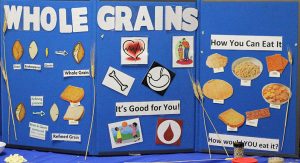What’s the whole story on whole grains?
University of Illinois Extension — October 12, 2016  Whole grains month may be over, but there is still room for them in your daily meal plan.
Whole grains month may be over, but there is still room for them in your daily meal plan.
Grains are one component included in the United States Department of Agriculture’s MyPlate model of balanced and healthy meals. Grains are defined as any food made with wheat, rice, oats, cornmeal, barley or cereal grain.
“Whole grain is much more than a buzz word,” said University of Illinois Extension Educator Jessica Gadomski, a registered dietician for SNAP-Education. “Whole grains are more nutritious than refined grains, as they contain the entire grain kernel or the whole grain with bran, endosperm and germ. Whole grains provide fiber, vitamins and minerals.”
Refined grains contain part of the grain kernel, as the bran and germ are removed. The refining process also removes nutrients like fiber, vitamins and minerals. Most refined grains are enriched, a process where nutrients are put back into the product, but this does not make them whole grains, explained Gadomski.
“MyPlate recommends that at least half of all grains eaten be whole grains,” said Gadomski.
Children should eat 3 to 8 ounces daily, depending on age and gender, and adults should consume 5 to 8 ounces. For specified recommendations, visit www.choosemyplate.gov/grains. In general, one slice of bread, one cup of ready-to-eat cereal, or ½ cup of cooked rice, cooked pasta, or cooked cereal can be considered as a one-ounce-equivalent.
“When selecting grains, don’t rely on product packaging words like bran, multi-grain, 100-percent wheat, stone ground, and cracked wheat,” said Gadomski. “They can be misleading. Instead trust the food label. Look for: “whole” or “100-percent whole-grain” listed first on the label.”
Popular whole grain choices may include brown rice or wild rice, oatmeal or rolled oats, popcorn, whole wheat, whole rye, and the newly popular quinoa.
Having a hard time adjusting to the flavor or texture of whole grain products? Gadomski suggests mixing it in slowly, like making a sandwich with one slice of white and one slice of wheat bread, or using half enriched and half whole wheat when it comes to pasta, or half brown and half white rice.
Maybe you are ready to expand your whole grain offerings at home? Gadomski offers a list of few less common choices that you can explore:
· Buckwheat
· Bulgur
· Millet
· Whole-grain barley, corn, sorghum or triticale
Whole grains fit into any meal or snack, said Gadomski. From whole grain desserts like blueberry bean cake and apple crisp, to meal staples like French toast delight and whole grain pasta with chicken parmesan, visit Illinois Nutrition Education Program recipe resource at web.extension.illinois.edu/INEP/recipes-new.
“Many of your favorite grains come in whole grain options,” said Gadomski. “Next time you are at the store, check out the grain aisle. You may be surprised at what you find!”
For more information on fun, nutritious and budget-friendly options for your family, visit the Illinois Nutrition Education Program website at https://web.extension.illinois.edu/INEP/ and click on “healthy recipes.” With fall approaching, be sure to check out the apple tuna salad sandwich and sweet pumpkin sloppy joes.
— What’s the whole story on whole grains? —
Ad 1 – 300×250 – Google ROS
Trending News
 Randall Road detour in effect ...Motorists traversing Randall Road through the Miller Road intersection in Carpentersville have ...
Randall Road detour in effect ...Motorists traversing Randall Road through the Miller Road intersection in Carpentersville have ... Two killed in Eden Expressway ...Two people were killed in accidents on the Edens Expressway. A three-unit ...
Two killed in Eden Expressway ...Two people were killed in accidents on the Edens Expressway. A three-unit ... Bloomington man killed in truck ...A Bloomington man died from injuries sustained Wednesday morning when his truck ...
Bloomington man killed in truck ...A Bloomington man died from injuries sustained Wednesday morning when his truck ... Vietnam Veterans Memorial replica wall ...“The Wall That Heals,” a three-quarter scale replica of the Vietnam Veterans ...
Vietnam Veterans Memorial replica wall ...“The Wall That Heals,” a three-quarter scale replica of the Vietnam Veterans ...
Ad 2 – 300×250 – Google ROS



